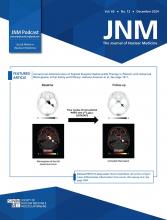Visual Abstract
Abstract
Despite the systemic impact of both cancer and the associated immune response, immuno-PET is predominantly centered on assessment of the immune milieu within the tumor microenvironment. The aim of this study was to assess the value of [18F]F-AraG PET imaging as a noninvasive method for evaluation of system-wide immune status of patients with non–small cell lung cancer before starting immunotherapy. Methods: Eleven patients with advanced non–small cell lung cancer were imaged with [18F]F-AraG before starting immunotherapy. Diagnostic [18F]FDG PET/CT scans were analyzed to assess differences in the extent of disease among patients. SUVmax, SUVmean, and total SUV (SUVtotal) from all tumor lesions, active lymph nodes, spleen, vertebral bone marrow, liver, thyroid, heart, and bowel were extracted from the baseline [18F]F-AraG scans, and discriminant and Kaplan–Meier analyses were performed to test their ability to predict patient response and overall survival. Results: The extent of the disease was variable in the patient cohort, but none of the [18F]FDG biomarkers associated with tumor burden (SUVmax, total metabolic tumor volume, and total lesion glycolysis) was predictive of patient survival. The differences in the [18F]F-AraG and [18F]FDG distribution were observed both within and between lesions, confirming that they capture distinct aspects of the tumor microenvironment. Of the 3 SUV parameters studied, [18F]F-AraG SUVtotal provided a dynamic range suitable for stratifying tumors or patients according to their immune activity. [18F]F-AraG SUVtotal measured in the lumbar and sacral vertebrae differentiated between patients who progressed on therapy and those who did not with 90.9% and 81.8% accuracy, respectively. The Kaplan–Meier analysis revealed that patients with high [18F]F-AraG SUVtotal in the lumbar bone marrow had significantly lower probability of survival than those with a low signal (P = 0.0003). Conclusion: This study highlights the significance of assessing systemic immunity and indicates the potential of the [18F]F-AraG bone marrow signal as a predictive imaging biomarker for patient stratification and treatment guidance.
Footnotes
Published online Oct. 24, 2024.
- © 2024 by the Society of Nuclear Medicine and Molecular Imaging.
This article requires a subscription to view the full text. If you have a subscription you may use the login form below to view the article. Access to this article can also be purchased.
SNMMI members
Login to the site using your SNMMI member credentials
Individuals
Login as an individual user








